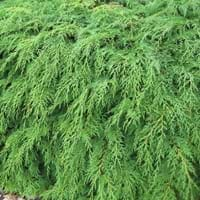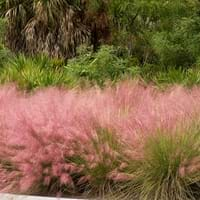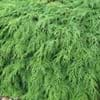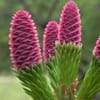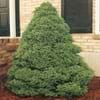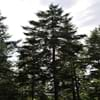Life Span
Perennial
Annual
Type
Needled or Scaled Evergreen
Grass
Origin
Russia/Siberia
Northeastern United States, Southeastern United States, South-Central United States, Mexico, Caribbean
Types
Not available
Evergreen
Habitat
Cold Regions
Coastal Regions, Pastures
USDA Hardiness Zone
4-7
5-10
Sunset Zone
A3, 1a, 1b, 2a, 2b, 3a, 3b, 4, 5, 6, 7, 8, 9, 10, 14, 15, 16, 17
4, 5, 6, 7, 8, 9, 10, 11, 12, 13, 14, 15, 16, 17, 18, 19, 20, 21, 22, 23, 24
Habit
Spreading
Clump-Forming
Flower Color
Dark Green
Pink
Flower Color Modifier
Bicolor
Bicolor
Fruit Color
Non Fruiting Plant
Not Available
Leaf Color in Spring
Green
Green
Leaf Color in Summer
Green, Dark Green
Light Green
Leaf Color in Fall
Green, Dark Green, Copper
Green, Brown
Leaf Color in Winter
Purple, Sienna, Burgundy, Bronze
Tan, Brown
Leaf Shape
Scale-like imbricate
Grass like
Plant Season
Spring, Summer, Fall, Winter
Spring, Summer, Fall, Winter
Sunlight
Full Sun, Partial Sun, Partial shade
Full Sun, Partial Sun, Partial shade
Type of Soil
Clay, Loam
Clay, Loam, Sand
The pH of Soil
Acidic, Neutral
Acidic, Neutral, Alkaline
Soil Drainage
Well drained
Average
Bloom Time
Not Available
Late Summer, Early Fall, Fall
Tolerances
Shade areas
Wet Site, Drought, Salt, Soil Compaction
Where to Plant?
Ground
Ground
How to Plant?
Seedlings, Semi-hardwood cuttings
Seedlings
Plant Maintenance
Low
Medium
Watering Requirements
Water during dry weather, Water occasionally
Medium
In Summer
Lots of watering
Lots of watering
In Spring
Moderate
Moderate
In Winter
Average Water
Average Water
Soil pH
Acidic, Neutral
Acidic, Neutral, Alkaline
Soil Type
Clay, Loam
Clay, Loam, Sand
Soil Drainage Capacity
Well drained
Average
Sun Exposure
Full Sun, Partial Sun, Partial shade
Full Sun, Partial Sun, Partial shade
Pruning
Remove damaged leaves, Remove dead branches, Remove dead leaves
Remove damaged leaves, Remove dead branches, Remove dead leaves
Fertilizers
slow-release fertilizers
All-Purpose Liquid Fertilizer
Pests and Diseases
No serious insect or disease problems
Red blotch
Plant Tolerance
Shade areas
Drought
Flowers
Insignificant
Showy
Flower Petal Number
Single
Single
Foliage Texture
Fine
Fine
Foliage Sheen
Matte
Matte
Attracts
Bees, Butterflies, Hummingbirds
Butterflies
Allergy
Not Available
Not Available
Aesthetic Uses
Cottage Garden, Ground Cover
Showy Purposes
Beauty Benefits
Not Available
Not Available
Environmental Uses
Not Available
Air purification
Medicinal Uses
Not Available
Not Available
Part of Plant Used
Not Available
Leaves
Other Uses
Used for bedding in gardens
Showy Purposes
Used As Indoor Plant
No
No
Used As Outdoor Plant
Yes
Yes
Garden Design
Alpine, Edging, Feature Plant, Foundation, Groundcover, Mixed Border, Rock Garden, Wall
Bog Garden, Container, Feature Plant, Groundcover, Mixed Border, Rock Garden / Wall
Botanical Name
MICROBIOTA decussata
MUHLENBERGIA capillaris 'Regal Mist'
Common Name
Microbiota, Siberian carpet cypress, Russian arbor vitae
Pink Muhly Grass, Texas Muhly Grass
In Hindi
माइक्रोबायोटा
pink muhly grass
In German
Mikrobiota
pink muhly grass
In French
microbiote
pink muhly grass
In Spanish
microbiota
pink muhly grass
In Greek
μικροχλωρίδας
pink muhly grass
In Portuguese
microbiota
pink muhly grass
In Polish
mikroflory
pink muhly grass
In Latin
Microbiota
pink muhly grass
Phylum
Tracheophyta
Magnoliophyta
Class
Pinopsida
Liliopsida
Family
Cupressaceae
Poaceae
Genus
Microbiota
Muhlenbergia
Clade
Not Available
Angiosperms, Commelinids, Monocots
Tribe
Not Available
Not Available
Subfamily
Not Available
Not Available
Number of Species
Not Available
Importance of Microbiota and Pink Muhly Grass
Want to have the most appropriate plant for your garden? You might want to know the importance of Microbiota and Pink Muhly Grass. Basically, these two plants vary in many aspects. Compare Microbiota and Pink Muhly Grass as they differ in many characteristics such as their life, care, benefits, facts, etc. Every gardener must at least have the slightest clue about the plants he wants to plant in his garden. Compare their benefits, which differ in many ways like facts and uses. The medicinal use of Microbiota is Not Available whereas of Pink Muhly Grass is Not Available. Microbiota has beauty benefits as follows: Not Available while Pink Muhly Grass has beauty benefits as follows: Not Available.
Compare Facts of Microbiota vs Pink Muhly Grass
How to choose the best garden plant for your garden depending upon its facts? Here garden plant comparison will help you to solve this query. Compare the facts of Microbiota vs Pink Muhly Grass and know which one to choose. As garden plants have benefits and other uses, allergy is also a major drawback of plants for some people. Allergic reactions of Microbiota are Not Available whereas of Pink Muhly Grass have Not Available respectively. Having a fruit bearing plant in your garden can be a plus point of your garden. Microbiota has no showy fruits and Pink Muhly Grass has no showy fruits. Also Microbiota is not flowering and Pink Muhly Grass is not flowering . You can compare Microbiota and Pink Muhly Grass facts and facts of other plants too.
